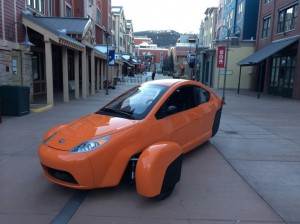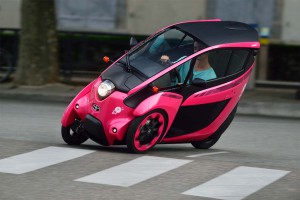An autocycle?
It’s a vehicle classification that most folks don’t give much thought, but 26 states have laws or are developing them, for three-wheeled, enclosed vehicles otherwise known as autocycles.
Perhaps the best known of the group currently is the Elio from Elio Motors, which touts 84 mpg for just $6,800 with the bonus of being American made: in a former General Motors plant in Shreveport, Louisiana.
Not surprisingly, the latest piece of legislation, initiated by Sen. David Vitter (R-La.)., and dubbed the Autocycle Safety Act would create a specific “autocycle” classification at the federal level. It would set guidelines for safety as well as Corporate Average Fuel Economy standards.
“Creating this recognition for autocycles will ensure their safety, create jobs, and encourage the same entrepreneurial spirit that created motor vehicles and motor cycles,” Vitter said in a statement.
“This update to an outdated law will also help spur job creation in Louisiana, since Elio Motors has selected Shreveport for their manufacturing plant, and it will also ensure that imported vehicles of similar types will be covered by the same safety standards that domestic manufacturers will follow.”
Elio Motors isn’t the first company to develop a three-wheeled vehicle. There are plenty of options, including the Toyota i-Road, Tanom Motors Invader, Campagna T-Rex and the Polaris Slingshot, each sharing a similar set up to the Elio – two wheels UP front and one in the rear.
There have been many others throughout the years, including the infamous Robin in Great Britain, which has one wheel in the front, two in the back and a propensity to roll over. Automotive engineers believe the new layout followed by the Elio is fundamentally more stable.
While from a physics standpoint that may be true, but it has been a challenge getting them into widespread distribution. This is due, in part, to the mix of often conflicting laws governing three-wheeled vehicles.
Currently, these vehicles are considered motorcycles by the National Highway Traffic Safety Administration, which is clearly not what they are, according to the American Association of Motor Vehicle Administrators (AAMVA). The group assembled a collection of officials, the Three-Wheel Vehicle Working Group (3WVWG), to help set the rules for what constitutes a motorcycle and what is an autocycle and what rule should be in place for the latter.
(Paris the latest city to restrict autos. For more, Click Here.)
“Not only will Senator Vitter’s legislation provide consistency across all jurisdictions, but it strongly supports his efforts to bring jobs back to the Shreveport area,” said Paul Elio, founder and CEO, Elio Motors. “We are thrilled at Senator Vitter’s efforts recognizing the need for a new classification of innovative, ultra-efficient platforms like the Elio Autocycle.”
Vitter’s legislation along with other transportation trends has many rethinking what the vehicle of the future will look like and exactly how drivers will get from Point A to Point B.
A growing number of manufacturers – along with Google and, apparently, Apple – re working to develop autonomous vehicles. And as the little Google car prototype demonstrates, they may look very different from the vehicles of today, partially a result of demands of federal fuel economy standards jumping to 54.5 mpg by 2025. Further adding to the challenge, a number of cities are looking to restrict the types of vehicles – driving in overcrowded city centers.
Helsinki, Finland, is considering a plan that could replace private car ownership with carsharing, bikes and public transport. The plan would let residents pay a flat fee that would cover any and all of their urban transportation needs.
(Click Here for Dubai’s plans for alleviating traffic congestion.)
Other cities are going a step further, moving toward banning cars all together. Hamburg, Germany, is developing its Green Network Plan, which would expand public transport and add more routes for pedestrians and bicyclists. But the most controversial aspect calls for a steady phase-out of automobiles in the city center over the next two decades.
London, Paris and others have severely restricted vehicles in the cities, calling them green rings. London issues a congestion charge for vehicles driving into the center of the city: 10 British pounds per day, or nearly $17.
Put all these factors together and they could be a boon to autocycles – if the government can ever figure out precisely what they are and how to regulate them.
In fact, when Toyota showed off the i-Road earlier this year, officials envisioned it being used as supplemental transportation. Commuters would drive to stations outside of a city and then transfer to i-Roads to complete their trip. The Japanese maker is actually putting that concept to the test with pilot programs in Japan and France.
(To see more about cities contemplating going carless, Click Here.)
As those programs iron out their kinks and companies like Elio and others inch closer to delivering personal transportation, the real change in personal commuting will likely be dictated by government regulation.
The winners will be those that can adapt to those rules quickly and provide innovation in the process.



Elio is vaporware. They need to raise something like $230mil to go into production. They don’t have production tooling yet.
Politics at work. I wonder how much PAC money was contributed?
“including the infamous Robin in Great Britain, which has one wheel in the front, two in the back and a propensity to roll over”.
Has one wheel, eh. Had would be a more appropriate word. What century are we in? The Reliant series were about the only 3 wheelers made backwards and that was 40 to 60 years ago.
Anyone with a shred of sense puts the two wheel axle in front, ever since Morgan did in 1908. Reliant were the exception that proves the rule.
Elio Motors seems to be run on the “Dr Snively’s Traveling Medicine Show” principle. Feed ’em guff and they’ll cough up deposits which will be used in the almost maniacally farcical pursuit of an unachievable dream. Then issue encyclicals every now and then to speak in the most optimistic tones possible about the “massive” advances recently made.
Not a bad job if you can convince enough people you’re actually serious along the way. I bet the donations aren’t audited. But I’m a skeptical SOB.
“has” for the reliant robin is sorta appropriate as there are still runners in northern england. not only that, but the zap zebra electric car updated the robin into an environmentalists road going hazard ….
Why not look at adopting the European light quadcycle rules and calling it a day. Why reinvent the wheel once again. We need to standardize our safety and enviro requirements with the world, both making some changes, so transportation will be cheaper for all.